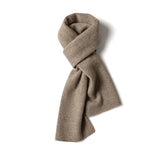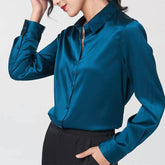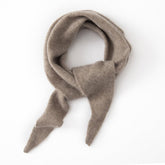What is a Kimono?
The kimono is a traditional Japanese garment known for its distinctive design and cultural significance. The main difference between a kimono and other types of clothing is in its unique construction and the traditions and symbols associated with wearing it.
While kimonos are often worn on special occasions, modern garments like robes, often called the modern kimono, provide comfort and flexibility for everyday use. Slipintosoft offers luxurious silk robes that deliver an elegant alternative to traditional kimonos. Here's our breakdown of what a kimono is!
Key Takeaways
- The kimono is a traditional Japanese garment with deep cultural roots.
- It features distinct elements, including the obi, which is a sash used to secure the garment.
- Traditional kimonos have evolved from formal wear to include modern styles and uses.
- Kimono rental shops are popular for those wishing to experience wearing a kimono without purchasing one.
What are Kimonos?
Kimonos are traditional Japanese garments easily recognized by their long sleeves, wrap-around design, and intricate patterns. They are usually made of silk or other fine fabrics. Kimonos can vary in color and style, reflecting the personality of those who wear kimono garments and the occasion. The term “kimono” itself translates to “thing to wear,” highlighting its role as an essential item of clothing in Japanese culture.
Kimonos are often decorated with beautiful motifs such as cherry blossoms or seasonal patterns, which convey deeper meanings related to nature and life events. For instance, a crane is the most prevalent bird used on kimonos because it symbolizes good luck and long life. Depending on the type of kimono worn, they can be used by both men and women, making them a flexible choice in Japanese clothing. While traditionally associated with formal occasions like tea ceremonies or weddings, kimonos can also be adapted for casual settings, especially in modern interpretations.
The History of the Ancient Japanese Kimono


The history of the kimono dates back to the Nara period (AD 710 to 794) when it began to take shape as a distinct garment influenced by Chinese attire. During this time, the layering of clothing became popular among the aristocracy, leading to styles such as the jūnihitoe, which consisted of multiple layers. The Heian period (AD 794 to 1185) led to further refinement of the kimono's design, where color combinations and fabric choices became significant indicators of social status.
By the Edo period (AD 1603 to 1868), the kimono had evolved into an art form, with strict regulations governing its use based on class and occasion. This era also marked the rise of specialized artisans in cities like Kyoto, who created exquisite silk kimonos using advanced dyeing techniques. As Japan entered the modern era at the end of the 19th century, Western clothing began to influence daily attire; however, the kimono remained a cherished symbol of Japanese culture.
Design Elements of the Traditional Japanese Kimono Garment
|
Element |
Description |
|
Sleeves |
Length varies by occasion; longer for formal, shorter for casual |
|
Obi |
Decorative wide belt that secures and improves the kimono |
|
Fabric |
Silk for formal; cotton or polyester for casual or summer |
|
Motifs |
Nature-inspired patterns, e.g., cherry blossoms for spring |
The traditional Japanese kimono is composed of a few key design elements that contribute to its elegance and functionality. One of the most notable features is the kimono sleeve, which can vary in length depending on whether it is designed for formal or casual wear. Kimonos are usually secured with an obi — a wide belt that holds the garment in place and adds an aesthetic element through its intricate designs.
Additionally, the fabric used in making Japanese traditional kimonos plays an important role in their overall appearance. Traditional kimono fabric includes silk, which is popular for its luster and drape, as well as cotton or polyester options for more casual or summer wear. Patterns on kimonos often incorporate kimono motifs that represent various themes from nature or cultural symbols. For instance, women's kimono motifs featuring cherry blossoms are especially popular during springtime festivals, much like men's kimono options.
Kimonos in the Modern Day

We’ve outlined the main differences between traditional and modern kimonos below:
|
Feature |
Traditional Kimono |
Modern Kimono |
|
Significance and Use |
|
|
|
Design and Material |
|
|
|
Functionality |
|
|
In contemporary Japan, kimonos have transitioned from everyday wear to being mainly reserved for special occasions such as weddings, graduations, and festivals (e.g., Coming of Age Day). While traditional styles remain popular, modern interpretations have emerged that blend traditional elements with contemporary fashion trends. This has led to an increased interest in kimono rental services that allow individuals to experience wearing a classic silk kimono without committing to purchasing one.
Many Japanese people now incorporate kimonos into their daily lives through casual versions known as yukata — lightweight and often worn during summer festivals. These adaptations reflect a growing appreciation for traditional garments while accommodating modern lifestyles. As interest in Japanese culture continues to spread globally, many fashion designers have drawn inspiration from kimonos. This has led to innovative designs that resonate with international audiences.
Slipintosoft: Comfortable Silk Robes
While kimonos hold a special place in Japanese culture, they may not always be practical for everyday use. At Slipintosoft, we offer luxurious silk robes designed for comfort without sacrificing elegance. Our robes for women and men offer a stylish alternative for those who appreciate fine fabrics but prefer more flexible clothing options.
Our silk robes embody similar qualities of craftsmanship and comfort that make them ideal for lounging or casual outings. Whether you're looking for something to wear at home or during informal gatherings, our collection provides an excellent way to enjoy luxurious fabric in style.
What is a Kimono FAQs
Do you wear anything under a kimono?
Yes, traditionally, Japanese men and women wear a specific undergarment called a “juban” under a kimono, which helps keep the kimono clean and in place. The juban adds a layer between the wearer's skin and the kimono, allowing the outer garment to maintain its form and elegance.
What do the colors of kimonos mean?
The colors of a kimono often reflect the wearer's age, marital status, season, and occasion. Vibrant colors typically symbolize youth, and more muted tones are used for formal events like a funeral. Over time, kimono colors and patterns have also taken on symbolic meanings rooted in cultural and seasonal themes, showcasing a kimono and kimono's connection to tradition.
Can I wear a kimono if I'm not Japanese?
Yes, many people around the world buy and wear kimonos respectfully as part of appreciating Japanese culture. Museums like the Victoria and Albert Museum display kimonos as art, making them part of Japanese heritage shared globally through exhibitions and events.
Back to top: What is a Kimono?










